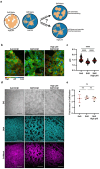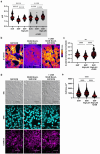This is a preprint.
Intracellular pH dynamics respond to extracellular matrix stiffening and mediate vasculogenic mimicry through β-catenin
- PMID: 38895391
- PMCID: PMC11185592
- DOI: 10.1101/2024.06.04.597454
Intracellular pH dynamics respond to extracellular matrix stiffening and mediate vasculogenic mimicry through β-catenin
Abstract
Dysregulated intracellular pH (pHi) dynamics and an altered tumor microenvironment have emerged as drivers of cancer cell phenotypes. However, the molecular integration between the physical properties of the microenvironment and dynamic intracellular signaling responses remains unclear. Here, we identify a mechanistic link between ECM stiffness and pHi dynamics in driving vasculogenic mimicry (VM), an aggressive cancer phenotype associated with poor prognosis. We performed single-cell imaging of pHi in lung and breast metastatic cell lines cultured on tunable-stiffness hydrogel systems. We used two tunable-stiffness hydrogel systems to independently model stiffness induced by increased protein secretion (Matrigel) and increased protein crosslinking (Hyaluronic acid gels). We show that increased ECM stiffness lowers single-cell pHi in both lung and breast metastatic cell lines. We also observed that stiff ECM promotes a distinct morphological phenotype called vasculogenic mimicry (VM). Importantly, we show that low pHi is a necessary mediator of VM, as raising pHi on stiff ECM reduces VM phenotypes. We also find that lowering pHi on soft ECM was sufficient to induce VM in the absence of extracellular stiffening. We characterized β-catenin as a pH-dependent molecular mediator of VM, where stiffness-driven increases in β-catenin abundance can be overridden by high pHi, which destabilizes β-catenin to reduce VM on stiff ECM. In contrast, the transcription factor FOXC2 is activated by ECM stiffness but is insensitive to pHi, and its activity alone is insufficient to maintain VM at high pHi when β-catenin is lost. We uncover a novel mechanotransduction axis in which ECM stiffness regulates intracellular pH to drive β-catenin-induced VM. We also show pHi dynamics can override mechanosensitive cell responses to the extracellular microenvironment. Thus, our work positions pHi as an integrator of mechanotransduction in cancer, suggesting a new framework for therapeutically targeting pHi in cancer and perhaps in other diseases driven by ECM remodeling.
Conflict of interest statement
Competing Interests: Authors declare no competing interests.
Figures






Similar articles
-
Intracellular pH regulates β-catenin with low pHi increasing adhesion and signaling functions.bioRxiv [Preprint]. 2025 Jun 14:2024.03.22.586349. doi: 10.1101/2024.03.22.586349. bioRxiv. 2025. PMID: 38585883 Free PMC article. Preprint.
-
Short-Term Memory Impairment.2024 Jun 8. In: StatPearls [Internet]. Treasure Island (FL): StatPearls Publishing; 2025 Jan–. 2024 Jun 8. In: StatPearls [Internet]. Treasure Island (FL): StatPearls Publishing; 2025 Jan–. PMID: 31424720 Free Books & Documents.
-
Comparison of Two Modern Survival Prediction Tools, SORG-MLA and METSSS, in Patients With Symptomatic Long-bone Metastases Who Underwent Local Treatment With Surgery Followed by Radiotherapy and With Radiotherapy Alone.Clin Orthop Relat Res. 2024 Dec 1;482(12):2193-2208. doi: 10.1097/CORR.0000000000003185. Epub 2024 Jul 23. Clin Orthop Relat Res. 2024. PMID: 39051924
-
Signs and symptoms to determine if a patient presenting in primary care or hospital outpatient settings has COVID-19.Cochrane Database Syst Rev. 2022 May 20;5(5):CD013665. doi: 10.1002/14651858.CD013665.pub3. Cochrane Database Syst Rev. 2022. PMID: 35593186 Free PMC article.
-
Systemic pharmacological treatments for chronic plaque psoriasis: a network meta-analysis.Cochrane Database Syst Rev. 2017 Dec 22;12(12):CD011535. doi: 10.1002/14651858.CD011535.pub2. Cochrane Database Syst Rev. 2017. Update in: Cochrane Database Syst Rev. 2020 Jan 9;1:CD011535. doi: 10.1002/14651858.CD011535.pub3. PMID: 29271481 Free PMC article. Updated.
References
Publication types
Grants and funding
LinkOut - more resources
Full Text Sources
Research Materials
